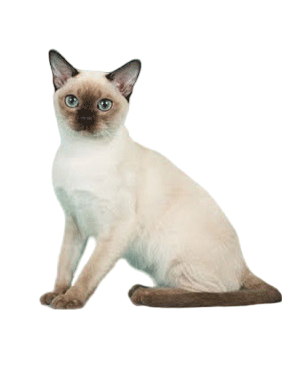 |
| Tonkinese Cat |
Tonkinese Cat Breed Information
If pedigreed cats ran for public office, the following advice from Ovid would make a tidy slogan for the Tonkinese candidate: "You will be safest in the middle.
Oh Canada
In the early 1960s a Canadian cat fancier named Margaret Conroy decided to cross a sealpoint Siamese and a sable Burmese in order to form a more perfect union: a cat that would be intermediate in appearance and temperament between the two. At that time the Siamese had not yet refined itself into the imperially slim, something-of-an-acquired-taste, art deco composition that it is today; and Burmese had yet to achieve the short-nosed contemporary look that has raised more than a few eyebrows and questions among cat fanciers. Nevertheless, Conroy was convinced that Siamese were beginning to evolve away from popular taste, and for this reason she determined that the cat world was ready for a new and clever hybrid that would occupy an equator between the hemispheres of functional and fashionable.
Making It Official
At first Conroy called her cats golden Siamese. That same term had been used, coincidentally, by a New York City pet-shop operator named Milan Greer, who had crossed Siamese and Burmese cats in the mid-1950s. After producing five generations of these oldy goldens, Greer apparently decided all that was gold did not glitter, and he lost interest in the project. There is no evidence that he or Conroy ever knew or knew of each another.
With a little help from some friends, Conroy wrote a standard for an "intermediate" breed and presented this standard to the Canadian Cat Association, whom she convinced to accept Tonkinese for registration and, ultimately, championship competition. This latter achievement, secured during the mid-1960s, gave Tonkinese the distinction of being the first breed developed in Canada. (The now-defunct Independent Cat Federation, in 1972, was the first American cat registry to recognize Tonkinese.) Read also: Bengal Cat Breed Information.
The cat described in Margaret Conroy's standard was neither slinky, like the Siamese, nor stocky, like the Burmese. Instead, the sensible-shoes Tonk was designed with a medium torso, moderately slim legs, well-developed muscles, a head with a modified wedge shape, and medium ears set as much on the side.
The More Things Change
In creating the Tonkinese, Conroy was, in fact, reinventing a hybrid. In 1930 a female cat named Wong Mau, from whom all Burmese cats are descended, arrived in the United States. Wong Mau was a brown cat with darker color on her extremities: face, legs, feet and tail. (These extremities are called points in the cat world.) Bred to a sealpoint Siamese Wong Mau produced both Siamese cats and other offspring that looked like herself, with darker bodies than the Siamese and with less contrast between point color and body color. Obviously, Wong Mau was a hybrid. In addition to being the matriarch of the Burmese breed, she was also the precursor of today's Tonkinese. In truth she was a Tonkinese cat before Tonkinese were invented.
By the end of the 1960s Margaret Conroy was no longer breeding cats, but by then the Tonkinese gospel had already spread to the United States, where it was capably presented by Jane Barletta (B'SSA cattery), who had formerly bred Siamese before switching to Tonks in 1965. An avowed believer in moderation--"I don't like to fool with Mother Nature; it bothers me"--Barletta was never moderate when it came to spending time, energy or money in the service of Tonkinese.
Colors and Patterns
The Tonkinese occurs in four different colors: blue, natural and also called seal or sable, platinum and also called lilac, champagne and also called chocolate. Those colors can be found in three patterns: solid, pointed and mink. A solid Tonkinese is virtually all of a piece with slightly lighter color on the underparts; a pointed Tonk is similar in color to a Siamese; and a mink recalls Wong Mau's medium-brown body that shaded to a lighter hue on its underparts and to a dark brown color at its points.
Solid Tonkinese have chartreuse eyes, ranging from greengold to yellowgreen. Pointed Tonks have bright blue eyes in shades from sky blue to violet, and mink Tonkinese have brilliant aqua-colored eyes, a distinctive and singular amalgam of the blue Siamese and golden Burmese eye color. This is the one area where the Tonkinese kicks up its heels. Otherwise, moderation remains the name of the game for this breed.
The natural mink Tonkinese, as we have seen, was the product of a sealpoint Siamese-to-sable Burmese breeding. The introduction of blue- and other-pointed Siamese and of blue Burmese to Tonkinese breeding programs made the blue mink, champagne mink and platinum mink colors possible. The fact that Tonkinese do not breed true for color led to the appearance of pointed and solid Tonkinese. Read also: Brazilian Shorthair Cat Breed Information.
Loyal Opposition
Although Siamese and Burmese breeders were wont to make pointed remarks at first about their cats' look-alike cousins with the sound-alike name, that attitude was toned down considerably over the years. "Most Siamese and Burmese breeders accept the Tonk as another legitimate breed," said one Tonkinese breeder ten years ago.
For its part, the cat-loving public has never shown anything but enthusiasm for Tonkinese. Visitors to cat shows who see pointed Tonkinese are given to exclaim, "Oh, that's like the Siamese we had for 15 years." Indeed, there's something of a demand for Tonkinese among people who had the old style Burmese or Siamese for a long time and now can't find
them anymore. For more details and information about Tonkinese Cat Breed, click here.

